Optical Designs for Popular McPherson Spectrometers, Spectrographs and Monochromators
 Using plentiful plane gratings with seperate focusing and collimating mirrors the Czerny-Turner design is one of the most popular. Linear wavelength positioning is acheived by grating rotation. The rotation point is coincident with the grating surface. The focus and collimating optics can be spherical, elliptical, toroidal or parabolic depending on instrument requirements. This design delivers a flat focal plane perfect for CCD detectors. Many instruments for the UV-Vis-IR and the Vacuum UV use this design.
Using plentiful plane gratings with seperate focusing and collimating mirrors the Czerny-Turner design is one of the most popular. Linear wavelength positioning is acheived by grating rotation. The rotation point is coincident with the grating surface. The focus and collimating optics can be spherical, elliptical, toroidal or parabolic depending on instrument requirements. This design delivers a flat focal plane perfect for CCD detectors. Many instruments for the UV-Vis-IR and the Vacuum UV use this design.
 The criss cross Czerny-Turner optical path minimizes the angle of incidence. This improves optical performance by reducing aberrations. The criss-cross variant of the Czerny-Turner is a McPherson patent. It is used exclusively in the 218 which is vacuum or purge compatible and works from 105nm to the LWIR.
The criss cross Czerny-Turner optical path minimizes the angle of incidence. This improves optical performance by reducing aberrations. The criss-cross variant of the Czerny-Turner is a McPherson patent. It is used exclusively in the 218 which is vacuum or purge compatible and works from 105nm to the LWIR.
 Normal Incidence monochromators use concave gratings to disperse and focus light. They work as short as 30nm by virtue of reduced optical surfaces. The `McPherson 15°' is a patented instrument with this design. The wavelength drive rotates and focuses the grating for best spectral resolution. These instrument are suitable for use with CCD and microchannel plate (MCP) intensified detectors. These designs are almost exclusively for the Vacuum UV.
Normal Incidence monochromators use concave gratings to disperse and focus light. They work as short as 30nm by virtue of reduced optical surfaces. The `McPherson 15°' is a patented instrument with this design. The wavelength drive rotates and focuses the grating for best spectral resolution. These instrument are suitable for use with CCD and microchannel plate (MCP) intensified detectors. These designs are almost exclusively for the Vacuum UV.
 The Seya-Namioka design uses 70°15' angle between entrance and exit slits. Concave, spherical, Rowland circle gratings are used. Some aberation corrected gratings are available that improve resolution. These designs are used mainly when experiments require work at less than 105nm and need a lot of space between slits to accomodate experiment chambers, light sources or detectors. These designs are almost exclusively for the Vacuum UV.
The Seya-Namioka design uses 70°15' angle between entrance and exit slits. Concave, spherical, Rowland circle gratings are used. Some aberation corrected gratings are available that improve resolution. These designs are used mainly when experiments require work at less than 105nm and need a lot of space between slits to accomodate experiment chambers, light sources or detectors. These designs are almost exclusively for the Vacuum UV.
 The modified Seya-Namioka or corrected holographic design uses corrected concave holographic gratings. The grating designs reduce astigmatism and improves spectral resolution. The result is our 234/302. A compact, fast optical system with good resolution and throughput. This is a popular instrument used from 30nm to the Visible region. These designs are almost exclusively for the Vacuum UV.
The modified Seya-Namioka or corrected holographic design uses corrected concave holographic gratings. The grating designs reduce astigmatism and improves spectral resolution. The result is our 234/302. A compact, fast optical system with good resolution and throughput. This is a popular instrument used from 30nm to the Visible region. These designs are almost exclusively for the Vacuum UV.
 Grazing Incidence instruments work from ~1 to >100nm. One slit travels the Rowland circle. CCD detectors mount normal to the exit ray, microchannel plate intensifiers tangent to the circle. Arrays can be scanned along the circle to intercept region of interest. A source can be mounted at the scanning slit for a calibration systems. These designs are almost exclusively for the Soft X-ray and Extreme UV.
Grazing Incidence instruments work from ~1 to >100nm. One slit travels the Rowland circle. CCD detectors mount normal to the exit ray, microchannel plate intensifiers tangent to the circle. Arrays can be scanned along the circle to intercept region of interest. A source can be mounted at the scanning slit for a calibration systems. These designs are almost exclusively for the Soft X-ray and Extreme UV.
 Flat field instruments rely on uniquely shaped grating substrates or aberration corrected groove design and spacing. These are useful instruments when the region of interest in known and fixed. They are somewhat limited in range of collection and provide a very simple instrument construction. Due to the demands on the grating few designs exist and these are costly. They also are the most elegant means to collect a low resolution extreme UV spectrum. These designs are almost exclusively for the Soft X-ray and Extreme UV.
Flat field instruments rely on uniquely shaped grating substrates or aberration corrected groove design and spacing. These are useful instruments when the region of interest in known and fixed. They are somewhat limited in range of collection and provide a very simple instrument construction. Due to the demands on the grating few designs exist and these are costly. They also are the most elegant means to collect a low resolution extreme UV spectrum. These designs are almost exclusively for the Soft X-ray and Extreme UV.